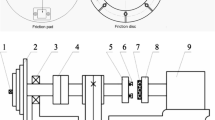Abstract
To develop a fundamental understanding of the tribological behavior of carbon fiber-reinforced silicon carbide (C/C–SiC) composites as brake pads and discs for high-speed trains, we have studied the brake friction properties of C/C–SiC composites at initial braking speeds ranging from 30 to 63 m/s. The friction mating pairs were fabricated by two methods to obtain composites of different SiC content. The composite with a SiC content of 40.3 % was used as the friction pad, and that with a SiC content of 85.6 % was used as the friction disc. In our experiments, an interesting turning point of 59 m/s was observed: the coefficient of friction (COF) decreased from 0.43 to 0.32 with increases in the braking speed from 30 to 49 m/s, at which braking speed it reached a plateau; the wear rate displayed a cubic curve against initial braking speed and reached a minimum of 315 mm3/MJ at 59 m/s. The topographical observations by scanning electron microscope combined with the residual stress analysis revealed that the limited number tribochemical layers, as well as the mismatch of thermal expansion coefficient between the carbon fiber and matrix, contribute to the unusual tribological characteristics of C/C–SiC composites. The experimental results suggest the good tribological potential of self-mated C/C–SiC composites in high-speed working conditions in terms of a steady COF and low wear rate.






Similar content being viewed by others
References
Aveston, J., Cooper G.A., Kelly A.: The properties of fiber composites. In: Conference Proceedings, p. 15. Guilford (1971)
Glass, D.E., Capriotti, D.P., Reimer, T., Kutemeyer, M., Smart, M.: Testing of DLR C/C–SiC for HIFiRE 8 Scramjet Combustor. In: 7th European Workshop on Thermal Protection Systems and Hot Structures. Noordwijk, the Netherlands (2013)
Renz, R., Seifert, G., Krenkel, W.: Integration of CMC brake disks in automotive brake systems. Int. J. Appl. Ceram. Technol. 9, 712 (2012)
Xiao, P., Li, Z., Xiong, X.: Microstructure and tribological properties of 3D needle-punched C/C–SiC brake composites. Solid State Sci. 12, 617 (2010)
Fan, S., Zhang, L., Xu, Y., Cheng, L., Tian, G., Ke, S., Xu, F., Liu, H.: Microstructure and tribological properties of advanced carbon/silicon carbide aircraft brake materials. Compos. Sci. Technol. 68, 3002 (2008)
Krenkel, W., Heidenreich, B., Renz, R.: C/C–SiC composites for advanced friction systems. Adv. Eng. Mater. 4, 427 (2002)
Li, Z., Xiao, P., Xiong, X., Huang, B.: Preparation and tribological properties of C fibre reinforced C/SiC dual matrix composites fabrication by liquid silicon infiltration. Solid State Sci. 16, 6 (2013)
Rak, Z.S.: Cf/SiC/C composites for tribological application. In: Krenkel, W., Naslain, R., Schneider, H. (eds.) High Temperature Ceramic Matrix Composites, pp. 820–825. Wiley-VCH Verlag GmbH & Co. KGaA, Weinheim (2001)
Vaidyaraman, S., Purdy, M., Walker, T., Horst, S.: C/SiC material evaluation for aircraft brake applications. In: Krenkel, W., Naslain, R., Schneider, H. (eds.) High Temperature Ceramic Matrix Composites, pp. 802–808. Wiley-VCH Verlag GmbH & Co. KGaA, Weinheim (2001)
Heidenreich, B., Krenkel, W.: Development of C/C–SiC materials for friction applications. In: Müller, G. (ed.) Ceramics: Processing, Reliability, Tribology and Wear, vol. 12, pp. 455–460. Wiley-VCH Verlag GmbH & Co. KGaA, Weinheim (2000)
Fan, S., Zhang, L., Cheng, L., Tian, G., Yang, S.: Effect of braking pressure and braking speed on the tribological properties of C/SiC aircraft brake materials. Compos. Sci. Technol. 70, 959 (2010)
Fan, X., Yin, X., He, S., Zhang, L., Cheng, L.: Friction and wear behaviors of C/C–SiC composites containing Ti3SiC2. Wear 274–275, 188 (2012)
Wang, Y., Wu, H.: Friction surface evolution of carbon fibre reinforced carbon/silicon carbide (Cf/C–SiC) composites. J. Eur. Ceram. Soc. 30, 3187 (2010)
Cai, Y., Fan, S., Liu, H., Zhang, L., Cheng, L., Dong, B., Jiang, J.: Microstructures and improved wear resistance of 3D needled C/SiC composites with graphite filler. Compos. Sci. Technol. 69, 2447 (2009)
Basu, B., Kalin, M.: Overview: tribological materials. Tribology of Ceramics and Composites: A Materials Science Perspective, pp. 7–17. Wiley, Hoboken (2011)
Zhang Q.: Thermal expansion behavior of C/SiC composites. PhD thesis. Northwestern Polytechnical University, Xi'an, Shaanxi (2004)
Guha, T.K., Basu, B.: Microfracture and limited tribochemical wear of silicon carbide during high-speed sliding in cryogenic environment. J. Am. Ceram. Soc. 93, 1764 (2010)
Acknowledgments
Support for this project was provided by the National Natural Science Foundation of China (No. U1134102) and Shandong Province Science and Technology Development Plan (No. 2014GGX102007).
Author information
Authors and Affiliations
Corresponding author
Rights and permissions
About this article
Cite this article
Li, G., Yan, Q., Jianren, X. et al. The Stability of the Coefficient of Friction and Wear Behavior of C/C–SiC. Tribol Lett 58, 13 (2015). https://doi.org/10.1007/s11249-014-0461-6
Received:
Accepted:
Published:
DOI: https://doi.org/10.1007/s11249-014-0461-6




